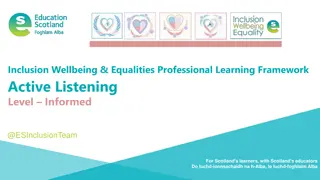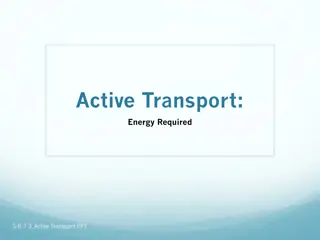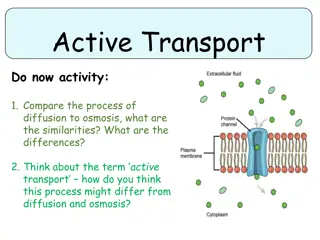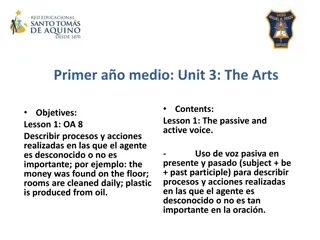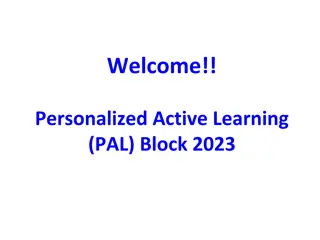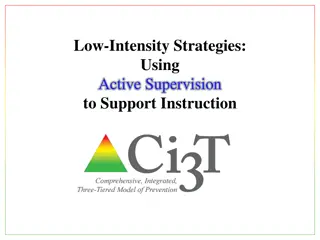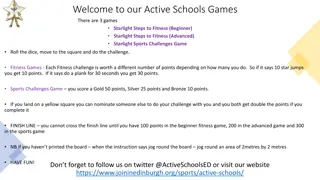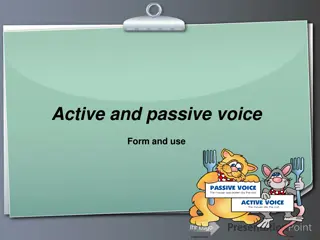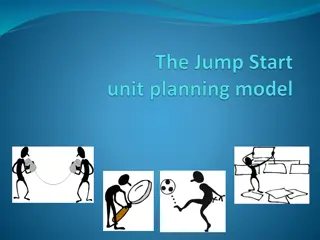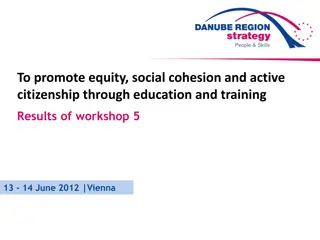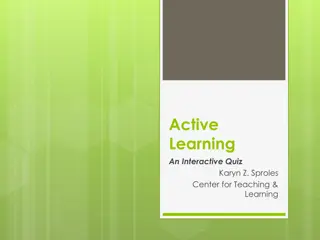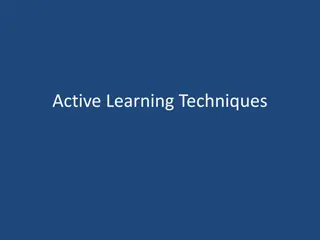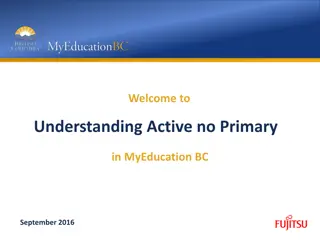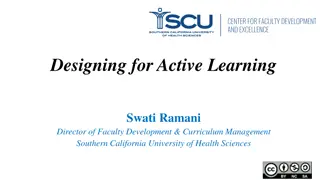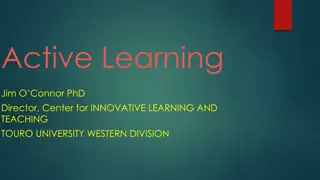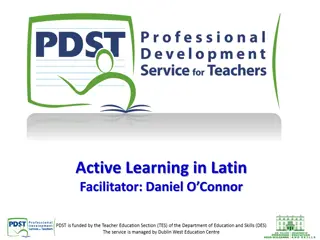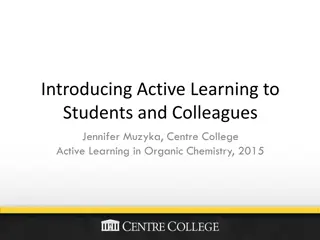Understanding Active Learning in Education
Active learning engages students in the learning process through meaningful activities and requires them to think about what they are doing. It is not a one-size-fits-all approach and can vary based on various factors. Theoretical underpinnings, such as Constructivist Learning Theory and Sociocultural Theory, support active learning. Evidence shows that incorporating active learning in courses improves student performance. Practical applications include think-pair-share, flipped classroom, video discussions, real-time polling, debates, and more.
Download Presentation

Please find below an Image/Link to download the presentation.
The content on the website is provided AS IS for your information and personal use only. It may not be sold, licensed, or shared on other websites without obtaining consent from the author. Download presentation by click this link. If you encounter any issues during the download, it is possible that the publisher has removed the file from their server.
E N D
Presentation Transcript
Introduction to Active Learning
What is Active Learning? Active learning is generally defined as any instructional method that engages students in the learning process. In short, active learning requires students to do meaningful learning activities and think about what they are doing (Prince, 2004) Active Learning can vary by discipline, class size, classroom dynamics, professor teaching style, etc. There is no one-size-fits-all approach to incorporating Active Learning.
Theoretical Underpinnings Constructivist Learning Theory emphasizes that individuals learn through building their own knowledge, connecting new ideas and experiences to existing knowledge and experiences to form new or enhanced understanding (Bransford et al., 1999). Sociocultural Theory states that learning takes place when students solve problems beyond their current developmental level with the support of their instructor or their peers (Vygotsky, 1978). Zone of Proximal Development and Scaffolding
Evidence in Support of Active Learning Students in traditional lectures were 1.5 times more likely to fail than students in courses with active learning. On average, student performance on exams, concept inventories, or other assessments increased by about half a standard deviation (about 6%) when some active learning was included in course design (Freeman et al., 2014). A 1998 study including over 6,000 students showed that interactive engagement techniques were associated with more than twice the average level of gain in learning than traditional method (Hake, 1998).
Passive v. Active Learning https://ecampus.oregonstate.edu/faculty/development/Active%20Learning%20V2.pdf I hear, and I forget I see, and I remember I do, and I understand. -Chinese Proverb Variety is critical to student engagement TED Talks are limited to 18 minutes Khan Academy videos are generally under 10 minutes (For more about the science of attention span: https://journals.physiology.org/doi/full/10.1152/advan.00109.2016)
Practical Application of Active Learning Think-Pair-Share Flipped Classroom or Just-In-Time Teaching (readings outside of class, an out-of-class discussion, then collaborative activities during class time) Video discussions (Flip Grid) Ask questions with real-time polling Low-stakes quizzes Debates Interview experts Demonstrations Peer learning (have students research and teach what they ve learned to the class) Game-based learning Collaborative assignments and projects (Google Slides, etc.) Analyze case studies Minute papers Muddiest point writing at the end of each session
What Active Learning Techniques Have You Used Successful? Periodic questions during a lecture Minute papers Student-led discussion Group work/pairs: Slack Groupme Discord Google Hangout PearDeck Zoom
Additional Resources Free four-hour course in Active Learning with practical applications: https://tophat.com/teaching-resources/courses/active-learning-course/ https://tophat.com/blog/active-learning/ List of activities to engage students in Active Learning: https://crlt.umich.edu/sites/default/files/Active_Learning_Continu um_CRLT.pdf https://omerad.msu.edu/teaching/teaching-strategies/active- learning-strategies
References Bradbury, N.A. (2016). Attention Span During Lectures: 8 Seconds, 10 Minutes, or More? Advances in Physiology Education, 40(4). https://doi.org/10.1152/advan.00109.2016 Bransford, J.D., Brown, A.L., and Cocking, R.R. (eds.) and Committee on Developments in the Science of Learning, National Research Council (1999). How People Learn: Brain, Mind, Experience, and School. National Academies Press. Freeman, S., Eddy, S.L., McDonough, M., Smith, M.K., Okorafor, N., Jordt, H., & Wenderoth, M.P. (2014). Active Learning Increases Student Performance in Science, Engineering, and Math. Proceedings of the National Academy of Sciences111(23). Hake, R.R. (1998). Interactive-Engagement versus Traditional Methods: A Six-Thousand- Student Survey of Mechanics Test Data for Introductory Physics Courses. American Journal of Physics, 66(64). https://doi.org/10.1119/1.18809 Oregon State University. (n.d.) Active Learning V2. https://ecampus.oregonstate.edu/faculty/development/Active%20Learning%20V2.pdf Prince, M. (2004). Does Active Learning Work? A Review of the Research. Journal of Engineering Education, 93(3), 223-231. https://www.engr.ncsu.edu/wp- content/uploads/drive/1smSpn4AiHSh8z7a0MHDBwhb_JhcoLQmI/2004-Prince_AL.pdf Vygotsky, L. S. (1978). Mind in Society: The Development of Higher Psychological Processes. Harvard University Press.


